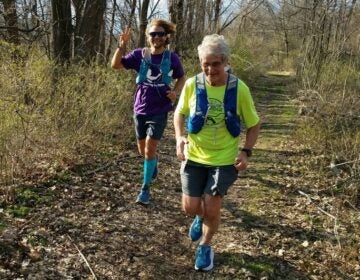Princeton’s new hospital emphasizes the importance of art in the healing process
If you were lying in a hospital room, what kind of art would you want to see? There are as many answers as there are patients. Now, hospitals are joining museums as places to exhibit artwork.
This is part of a series from Ilene Dube of The Artful Blogger.
If you were lying in a hospital room, what kind of art would you want to see? There are as many answers as there are patients. Now, hospitals are joining museums as places to exhibit artwork.
The Princeton area boasts two new hospitals that view art as an integral part of the healing process. Capital Health Systems opened in November, with 600 works of art by 70 artists, and next week, when the $447 million University Medical Center at Princeton opens its doors in Plainsboro, it will be greeting visitors, workers and patients with nearly 200 paintings and sculptures. Both hospitals have made a significant investment in showcasing artists from the local community.
“Most people recognize the many benefits of art as an integral part of their daily life,” says Barry Rabner, president and CEO of Princeton HealthCare System. “However, I suspect that many people do not realize that the visual arts have been shown to reduce anxiety, depression and pain. Art is another tool we are using at the new University Medical Center of Princeton at Plainsboro to help our patients get better.”
A growing body of research shows that art has healing powers, according to a statement from UMCP at Plainsboro. Art can help lower blood pressure, reduce the need for pain medications, and help people feel better faster.
“In an atmosphere where the patient often feels out of control, the arts can serve as a therapeutic and healing tool, reducing stress and loneliness and providing opportunities for self-expression,” says the Society for the Arts in Healthcare website.
Caregivers, who face human suffering, illness and death daily, can benefit from arts programming and the opportunity for self-expression. For physicians, observational and empathic abilities can be enhanced through the arts, and they may learn to understand and connect with patients in a more humane way.
UMCP’s Art for Healing Committee, made up of Princeton University Art Museum Curator of Modern and Contemporary Art Kelly Baum; architect/publisher J. Robert Hillier; Mercer County Community College art professor Michael Welliver; as well as hospital employees, physicians, members of the hospital auxiliary and the general public, drafted a statement of criteria for selecting art: it will do no harm, have a high likelihood of positively affecting viewers and foster inclusion and diversity.
“There will be no political or religious statements made by the art, because it’s not like a gallery where you can choose to walk in or out,” says committee member Andrea Honore.
Rosalyn Cama, an expert on evidence-based healthcare design, was brought on board to select the artwork.
Joe Stampe, Vice President of Development at the hospital, took me on a tour while finishing touches were being put on the new facility on its 171-acre campus off U.S. Route 1.
The curved building with single-patient rooms encompassing 630,000 square feet has louvred shades across its expanse of glass, allowing patients to see into the enormous atrium but retain privacy in their rooms.
There is a meditative water wall that promises peace and serenity. The cafeteria has been elevated to a restaurant, and looks out on a meditation garden with a large bronze “Fluke,” by Gordon Gund. Gund, a renowned sculptor, is CEO of Gund Investment Corp. and former co-owner of the Cleveland Cavaliers.
The Princeton resident lost his eyesight more than 40 years ago from retinitis pigmentosa. Gund goes to the fish market to feel his subjects before carving them in wood, for example the salmon jumping out of a reflecting pool in the front of the hospital. The finished works, in bronze, are the collections of the Philadelphia Museum of Art and Grounds For Sculpture.
Many of the artists here also have artwork at Capital Health Systems, about 10 minutes south on U.S. Route 1, such as Illia Barger, whose enormous painting of a red rose is considered a “wayfinder” for the chapel.
The Chapel of Light, designed by architect Bob Hillier, is illuminated by a skylight. Colored glass beads forming a curtain are coded to represent the old and new testaments of the Bible and the Koran. The chapel is for people of any, or no, faith. Fiber optics in the marble floor give it a shimmer.
In addition to the permanent artwork, there is an Art for Healing Gallery for rotating community art, as there was in the former building. Once the hospital moves from its Princeton location May 22 and the old building is decommissioned, artwork from that building will move to Plainsboro, including J. Seward Johnson Jr.’s lifelike sculpture of a nurse helping a patient in a wheelchair.
Perhaps the most artful aspect of this new hospital is that there will be no TVs in the waiting area. “We have found that people enjoy waiting in a quiet area,” says Stempe. “Landscapes like this,” he says, pointing to “The Sandy Road” by Princeton artist Charles McVicker,” have been found to lower blood pressure and allow people to escape.”
The Artful Blogger is written by Ilene Dube and offers a look inside the art world of the greater Princeton area. Ilene Dube is an award-winning arts writer and editor, as well as an artist, curator and activist for the arts.
WHYY is your source for fact-based, in-depth journalism and information. As a nonprofit organization, we rely on financial support from readers like you. Please give today.




